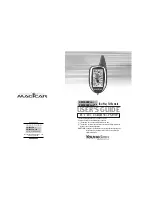
Appendix C. Calculating Network Restrictions
C-2
c)
What should the scan BufferOption be set to for this example?
The general rule is that the number of scan buffers should be enough to hold 2
seconds’ worth of data. With a scan rate of 20 ms, the BufferOption should be
2 s ÷ 0.02 s = 100. The CRBasic Scan() instruction would be written this way:
Scan
(20,msec,100,0)
d)
If there were four other CDM-A116s on the network with this same
configuration, what restraints would there be on the system?
Because the system can run in pipeline mode, each CDM-A116 can start its
measurements at the same time, not requiring any change in the scan rate. The
data generated (102.4 kbps) would be multiplied by a total of five CDM-A116s,
giving 512 kbps total. In order to keep up with this data output, the CPI speed
would need to be increased to 1000 kbps. This reduces the total allowable cable
length to 50 ft with the use of a termination plug, or 1 ft without (see TABLE
, Network Topology, Bit Rate, and Cable Length
(p. 28)
C.2 Example 2
a)
How many differential measurements can a CDM-A116 or CDM-
A108 make at 5 ms (200Hz) if input reversal is used?
This example uses the measurement time equation for measurements with input
reversal from TABLE
, Multiplexed Analog Voltage Measurement Speed
(p. 26)
Measurement Time = repetitions
•
�
2 •
�
T
settle
+
10
6
µs/s
f
N1
+ 180
µs
�
+ 5
µs
�
+ 31
µs
The equation shows that making multiple measurements by using the
Repetitions parameter within a measurement instruction is more efficient than
using multiple measurement instructions. Solving the previous equation for
repetitions gives the following:
repetitions
=
measurement time
−
31
µs
2
�
T
settle
+ 10
6
µs/s
f
N1
+ 180
µs
�
+ 5
µs
With f
N1
= 30000 Hz, T
settle
= 100 µs, and measurement time = 5 ms (5000 µs),
repetitions is calculated to be 7.866, so 7 repetitions, or measurements, are
possible at that scan rate.
repetitions
=
5000
µ
s
−
31
µs
2
�
100
µs
+ 10
6
µs/s
30000 Hz + 180
µs
�
+ 5
µs
= 7.866
b)
At that measurement rate, what is the best attainable resolution for
the measurements?
Resolution increases as the f
N1
decreases, but measurement time increases.
Solving the equation for f
N1
gives the following:
Summary of Contents for CDM-A100 Series
Page 2: ......
Page 3: ......
Page 7: ......
Page 11: ...Table of Contents iv ...
Page 45: ...CDM A100 Series 34 ...
Page 47: ......
Page 53: ...Appendix B Example Programs B 6 ...
Page 57: ...Appendix C Calculating Network Restrictions C 4 ...
Page 60: ......







































